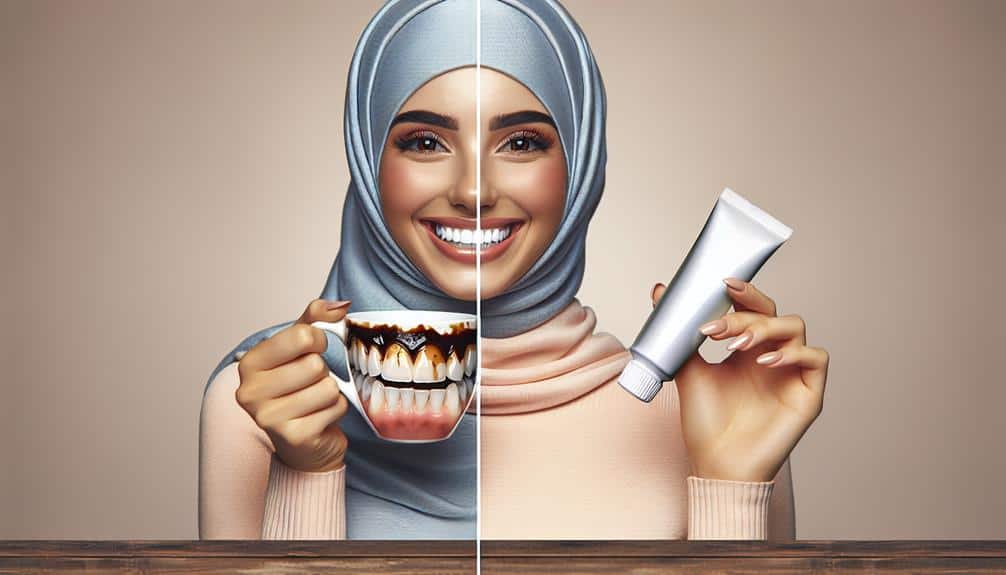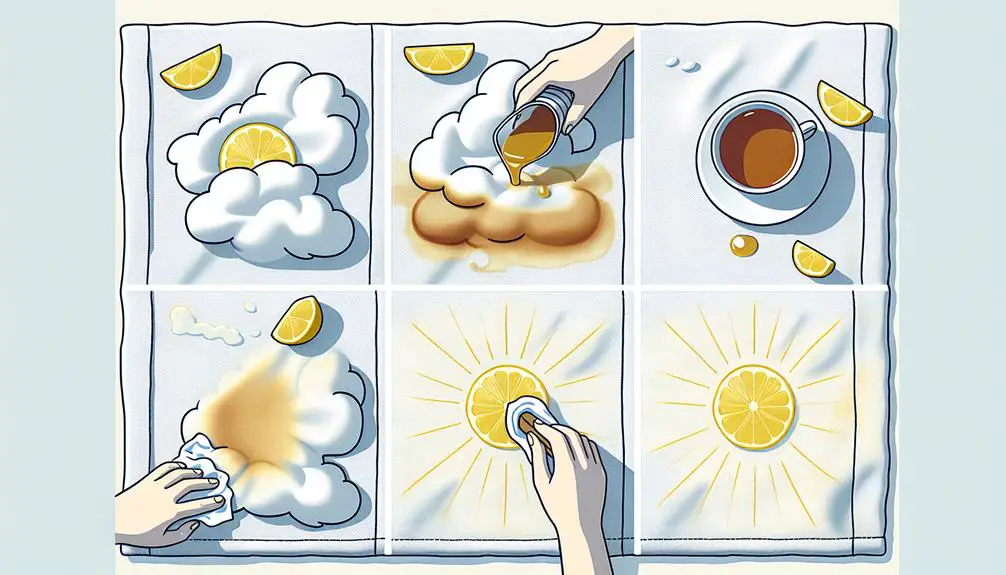Whiten tea-stained teeth by brushing with baking soda or rubbing orange peel. Create a paste with baking soda or use a strawberry scrub for natural whitening. Try oil pulling with coconut oil or brush with charcoal powder. Consider professional treatments for immediate results with stronger agents. Over-the-counter options like whitening toothpaste or strips can help. Opt for herbal toothpastes with neem or cinnamon. Be consistent for holistic remedies to work. Achieve a brighter smile with this exhaustive guide on whitening methods.
Key Points
- Utilize home remedies like baking soda and orange peel for natural whitening.
- Consider professional whitening options for immediate and lasting results.
- Use over-the-counter whitening products such as toothpaste and whitening strips.
- Try DIY remedies like baking soda paste and oil pulling with coconut oil.
- Opt for natural solutions with herbal toothpastes and oil pulling for effective stain removal.
Tea Stain Removal Techniques
To effectively remove tea stains from your teeth, consider utilizing proven home remedies or over-the-counter whitening products. Home remedies are a popular and cost-effective way to combat tea stains on your teeth. One preventive measure is to brush your teeth immediately after consuming tea to reduce the chances of stains setting in. Additionally, you can rinse your mouth with water after drinking tea to minimize the staining effect.
Another home remedy involves using baking soda as a gentle abrasive to scrub away surface stains caused by tea. Creating a paste with baking soda and water and brushing your teeth with it can help in whitening stained teeth. Moreover, rubbing the inside of a fresh orange peel on your teeth is believed to have a whitening effect due to the natural acidity of the fruit.
These home remedies, combined with preventive measures like regular brushing and rinsing, can assist in maintaining a brighter smile free from stubborn tea stains.
DIY Teeth Whitening Remedies
Consider exploring various do-it-yourself (DIY) teeth whitening remedies to effectively brighten your smile at home. Here are some homemade whitening treatments and natural tooth bleaching methods you can try:
- Baking Soda Paste: Mix a small amount of baking soda with water to create a paste. Gently brush your teeth with this mixture to help remove surface stains.
- Strawberry Scrub: Mash up a ripe strawberry and mix it with baking soda to create a natural scrub. Brush your teeth with this mixture to help whiten them.
- Oil Pulling: Swish a tablespoon of coconut oil around in your mouth for about 15-20 minutes. This method is believed to help remove bacteria and stains from your teeth.
- Activated Charcoal: Brushing with activated charcoal powder can help absorb stains and toxins from your teeth, aiding in whitening.
- Hydrogen Peroxide Rinse: Dilute hydrogen peroxide with water and swish it around in your mouth for a minute or two before spitting it out. This can help whiten teeth but should be used with caution.
These DIY remedies can be effective in brightening your smile, but remember to use them in moderation to prevent damage to your teeth.
Professional Whitening Options
Explore professional whitening options to achieve a brighter smile with long-lasting results. In-office treatments are a popular choice for those seeking immediate and effective solutions. Dentists offer professional whitening procedures that use stronger whitening agents than over-the-counter products, guaranteeing faster and more noticeable results. These treatments typically involve the application of a whitening gel or solution directly to the teeth, followed by the activation of the whitening agent using a special light or laser. The process is carefully supervised by dental professionals to guarantee safety and efficacy.
Professional solutions may also include customized at-home whitening kits prescribed by dentists. These kits consist of trays molded to fit your teeth perfectly and a professional-grade whitening gel. The advantage of these kits is that they're tailored to your specific needs and offer a more controlled whitening process compared to generic over-the-counter options. While professional whitening options may come at a higher cost, the results are often more significant and longer-lasting.
Over-the-Counter Whitening Products
When looking at addressing teeth discoloration, over-the-counter whitening products offer a convenient and accessible option for improving the brightness of your smile. These products are designed to help you achieve a whiter smile without the need for professional intervention. Here are some popular over-the-counter whitening options worth exploring:
- Whitening Toothpaste: Specialized toothpaste formulated with whitening agents can help remove surface stains and prevent further discoloration.
- Strips: Whitening strips are thin, flexible plastic strips coated with a whitening gel. They're placed directly on the teeth to bleach away stains.
- Home Remedies: Some over-the-counter products include natural ingredients like baking soda or activated charcoal, which can help whiten teeth over time.
- Gels: Whitening gels are peroxide-based solutions that are applied directly to the teeth with a brush or tray, offering a more targeted approach to whitening.
When using over-the-counter whitening products, it's crucial to follow the instructions carefully to achieve the best results without causing any harm to your teeth.
Natural Solutions for Tea-Stained Teeth
To tackle tea-stained teeth naturally, you can opt for homemade remedies that harness the power of common household ingredients to brighten your smile. Herbal toothpastes can be a great natural solution for tea-stained teeth. Look for toothpaste containing ingredients like neem, peppermint, or cinnamon, known for their natural whitening properties. These herbal toothpastes can help remove surface stains and promote a fresher breath.
Another effective natural remedy is oil pulling. This ancient technique involves swishing a tablespoon of coconut oil or sesame oil in your mouth for about 15-20 minutes. The oil helps to pull out toxins and bacteria, which can contribute to teeth staining. Regular oil pulling can gradually reduce the appearance of stains, leaving your teeth looking brighter.
Incorporating these natural solutions into your oral care routine can complement your efforts in whitening tea-stained teeth. Remember to be consistent and patient, as natural remedies may take some time to show visible results.
Frequently Asked Questions
Are There Any Specific Foods or Drinks That Should Be Avoided to Prevent Further Staining of Teeth After Whitening?
To prevent further staining after whitening, consider dietary restrictions. Avoid dark-colored beverages like coffee, tea, and red wine. Acidic foods, such as citrus fruits, can also contribute to staining. Opt for lighter options to maintain your bright smile.
How Often Should I Touch up or Re-Whiten My Teeth After Undergoing a Whitening Treatment?
To maintain your bright smile, touch up as needed every 6-12 months. Consistent upkeep guarantees long-term effectiveness of whitening treatments. Don't wait until stains reappear; stay proactive for lasting results that keep your teeth sparkling.
Can Tea-Stained Teeth Be a Sign of More Serious Dental Issues That Should Be Addressed by a Professional?
Tea-stained teeth can indicate underlying dental problems. Regular dental check-ups are essential. Seek professional advice for treatment options. Maintaining good oral hygiene is key. Addressing concerns promptly can prevent serious complications and guarantee a healthy smile.
Are There Any Specific Toothpaste or Mouthwash Products That Are Recommended for Maintaining Whitened Teeth?
Looking to maintain those pearly whites after whitening? Opt for toothpaste with baking soda or hydrogen peroxide for best results. Consider mouthwash brands like Crest 3D White or Listerine Healthy White for added brightness.
Are There Any Potential Side Effects or Risks Associated With Using Whitening Products or Treatments on Tea-Stained Teeth?
When whitening tea-stained teeth, be aware of potential risks like increased tooth sensitivity. It's essential to follow product instructions carefully and consult your dentist. Sensitivity concerns may vary, so monitor your teeth's response closely.



